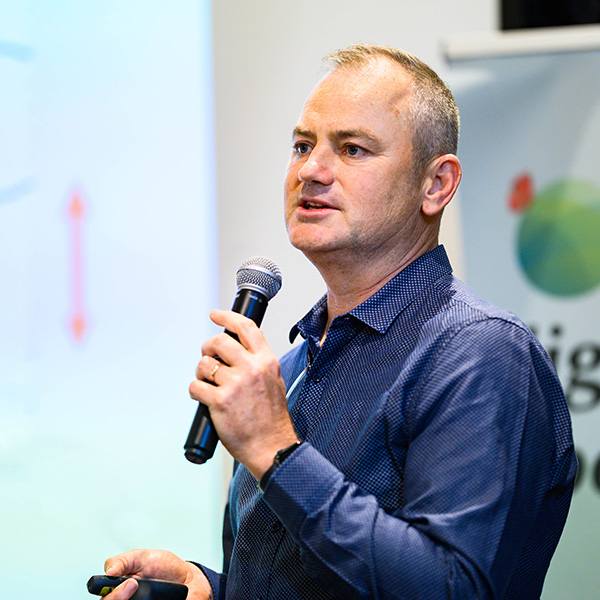Annual Energy Update 2023 with Simon Holmes à Court

Innovate 2023 – Lighter Footprints Co-convenor Mick Nolan welcomes Simon Holmes à Court at the Chandelier Room, Hawthorn Arts Centre
It’s been a momentous year in 2022.
In Australia, we are close to fossils/renewables crossover, Victoria’s electricity is now 40% clean, and in the US a Tesla Model 3 is now cheaper to drive away than the equivalent average US car.

We are approaching a fossils-renewables crossover, and through advocacy and political change we can improve policy, investment and innovation
Simon Holmes à Court reminded us that the transition is a once in lifetime economic opportunity. Let’s keep the momentum going then help push this with the virtuous cycle of public attitude & political change leading to better policies, investment, R&D, innovation and confidence.
Interested in energy and decarbonisation?
Read this quick take on Simon Holmes à Court’s analysis of where we going and where we have come from.
You can also
- Watch Simon’s presentation again here. Unless indicated links will take you to Simon’s discussion in the full presentation video.
- Download the slide set from our resources page here
- Visit our Facebook album here
- Look at live tweets – slides and notes – here.

Thanks to everyone who worked hard to make this evening a great start to the year!
Why are we here?
Why are we here? Simon Holmes à Court notes that CO2 levels are the highest in 800,000 years, driving corresponding CO2 increases and over 1°C degree temperature rises.
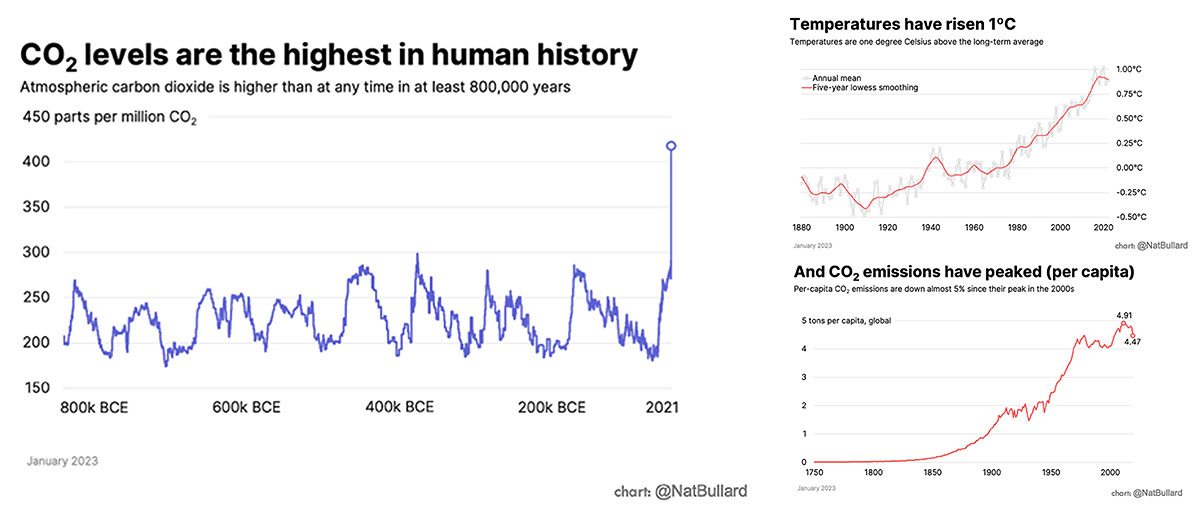
Humans have been around for at least 300,000 of these 800,000 years. But increasing CO2 from coal-driven industrialisation has unstabilised our climate
However finally emissions per capita are beginning to slow, “an early first step”.
“I’m haunted by this quote from Bill McKibben, the founder of 350 dot org.
He says, ‘Winning slowly is the same as losing.'”
– Simon Holmes à Court
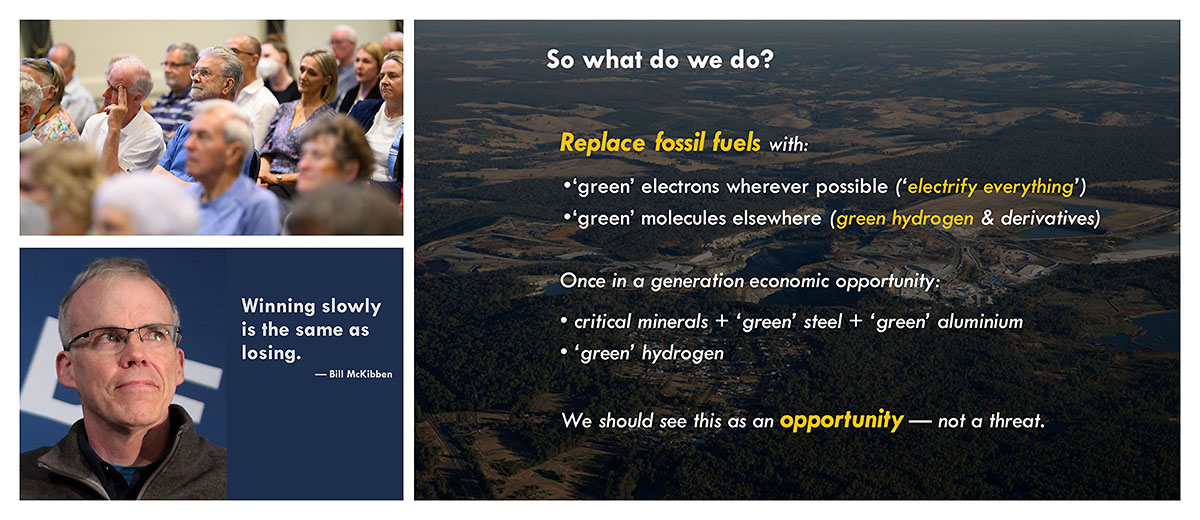
We have everything that is going to be needed for this new revolution to decarbonise our planet’s systems
- Electrify everything
- Replace fossil fuels with green electrons, or green molecules like green hydrogen
We should see the transition as a once-in-a-lifetime economic opportunity, we have everything we need – cheap clean energy and critical minerals to transform manufacturing and exports in Australia.
So What happened in 2022?
In 2022, global investment in the energy transition passed one trillion dollars for the first time, not just in clean energy (about half) but in other sectors too, particularly hydrogen.

“Over a trillion dollars was invested in the energy transition, about half of it, 500 billion was on renewable energy, just under 500 billion was on transport”
“So wind and solar are the majority of what’s going on in the renewable space. And solar, from a slower start than wind, is now growing most rapidly of all. And you can say that this growth trajectory, the amount of renewables we’re installing every year is exponential.”
Simon Holmes à Court

“What’s really exciting is that, say, a decade ago wind and solar were about 30% of investment in new energy. Now they’re making up nearly 80% of all generation.”
When it comes to new energy capacity, in 2022 wind and solar are driving the energy transition, reaching 80% of new investment, however, due to supply chain and geopolitical issues some prices have kicked up slightly.
“In fact, in the December quarter just finished gas usage was the lowest since I think 2004 or 2005. We are using less gas for generation every year.”
Simon Holmes à Court
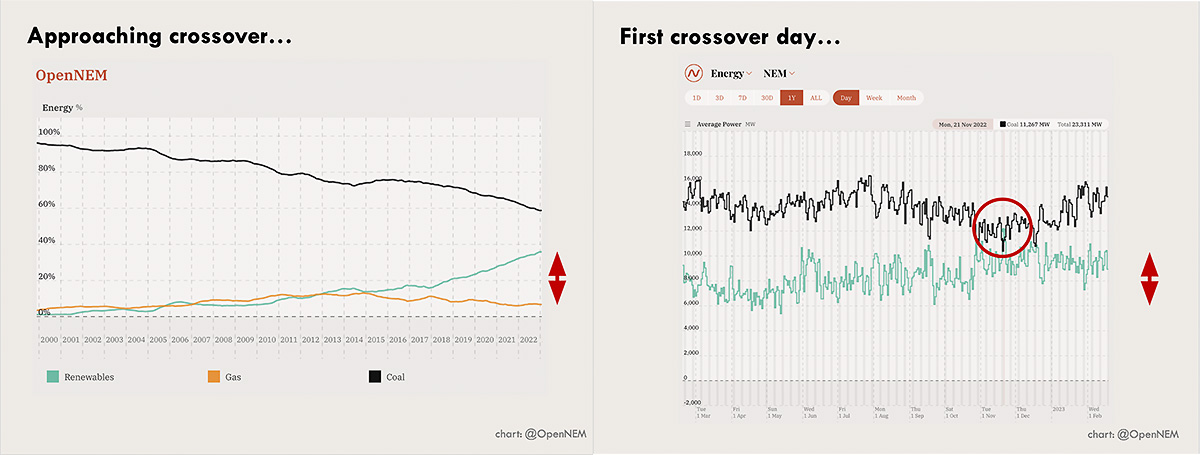
Approaching crossover “It won’t be long before these lines cross over and renewables become a greater part of the grid than coal.
Electricity generation is approaching fossils-renewables crossover. Gas peaked in 2014 and is going down. In fact on the 21st of November last year, clean energy in the NEM “generated more power or more energy into the grid than coal on that day. So just one day, last year. Pretty soon it’ll be a week, then a month, and then it’ll be full-time.”

What’s been happening in the grid in the last ten years? We’ve had solar grow by 1,345%, up 28 terawatt hours, like four or five good size coal power generators.”
In the last decade, renewables are driving out fossils – solar has increased by 1,345%, wind by 308%, pushing out gas (-44%) and coal (-20%).
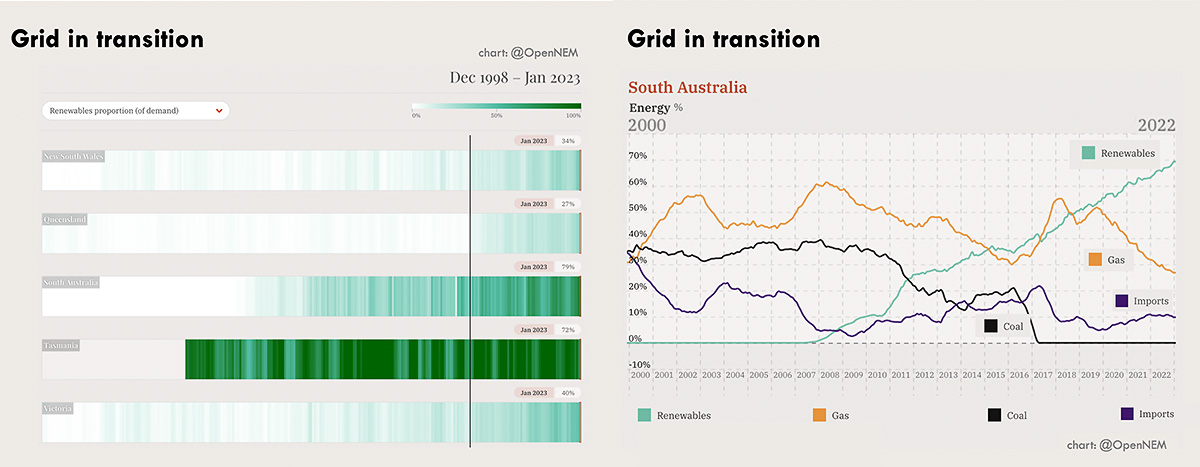
Bar graphs showing the greening of state grids, particularly in South Australia, where renewables have displaced coal and are displacing gas
State power is greening up, Victoria is now 40% renewables in the grid, and in South Australia you can see the massive rise of renewables – coal is gone, and gas generation is falling.
“But the standout success has been the renewables line here. It changed its trajectory and it’s on a nice continuous upward trajectory right now. In South Australia, they have a target to be net 100% renewable before the end of the decade. It looks like they’ll get there a few years early.”
Simon Holmes à Court
After the South Australian system blackout and the Finkel Review, AEMO started continuous assessment of future pathways, culminating in these massive Integrated System Plans. “Every two years they publish the latest thinking with all the latest assumptions of the costs of advancing of the technical models and they come up with a plan showing where we can go on the best available knowledge.”
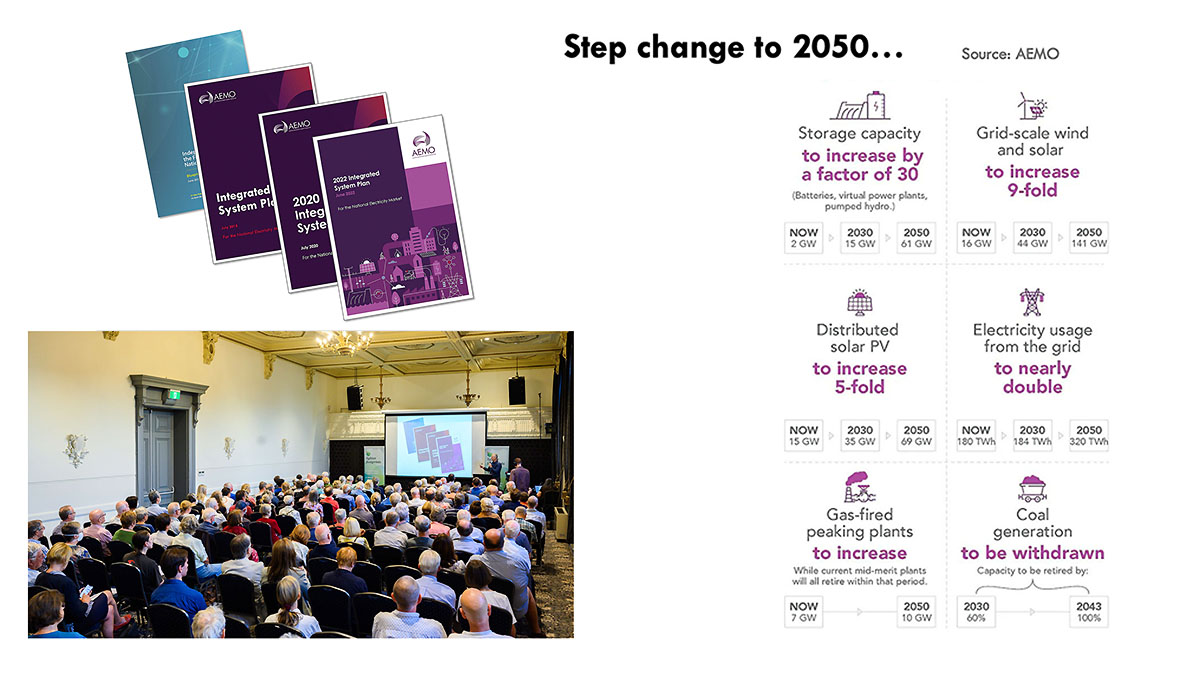
AEMO’s two yearly Integrated System Plan is based on extensive industry and public consultation followed by a process of review.
Storage will increase “by a factor of 30 over the next 30 years”, with a nine times increase in wind and a five times increase in distributed PV.
It’s important to remember that electricity is only one sector, only 30% of emissions. Its emissions are trending down, but worryingly other sectors remain static. Other sectors: Direct combustion is 19%, transport is 18%, agriculture is 15%, fugitives (mostly methane) is 9%, and industrial is 6%.
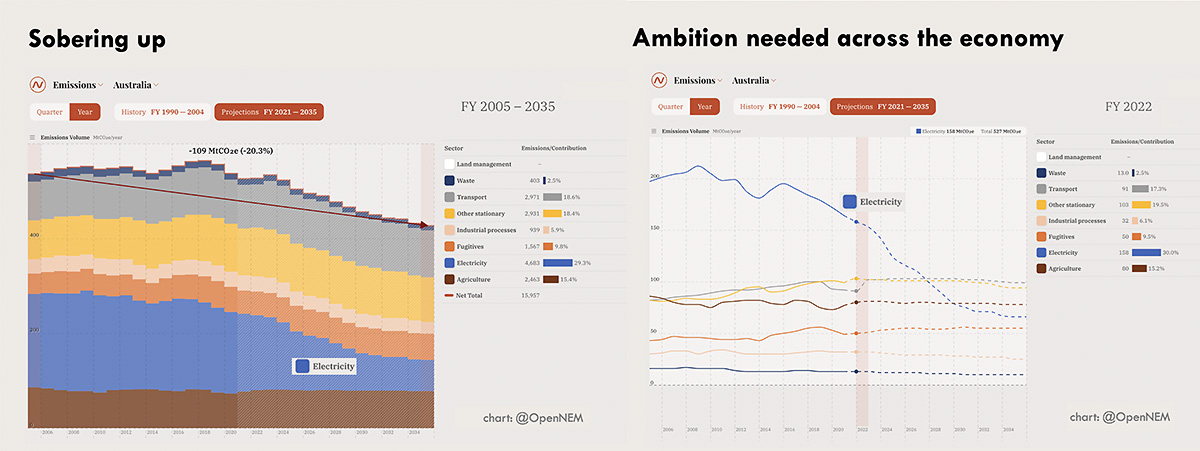
Forward projections to 2035 show that Electricity is the only sector to make decarbonisation gains. Transport, other types of stationery energy and methane leakage (fugitives) are significant.
Our emissions have hardly shifted – the visible drop is mostly due to a loophole that allows our emissions figures to include land clearing. Electricity is moving, other sectors are barely shifting or even going up.
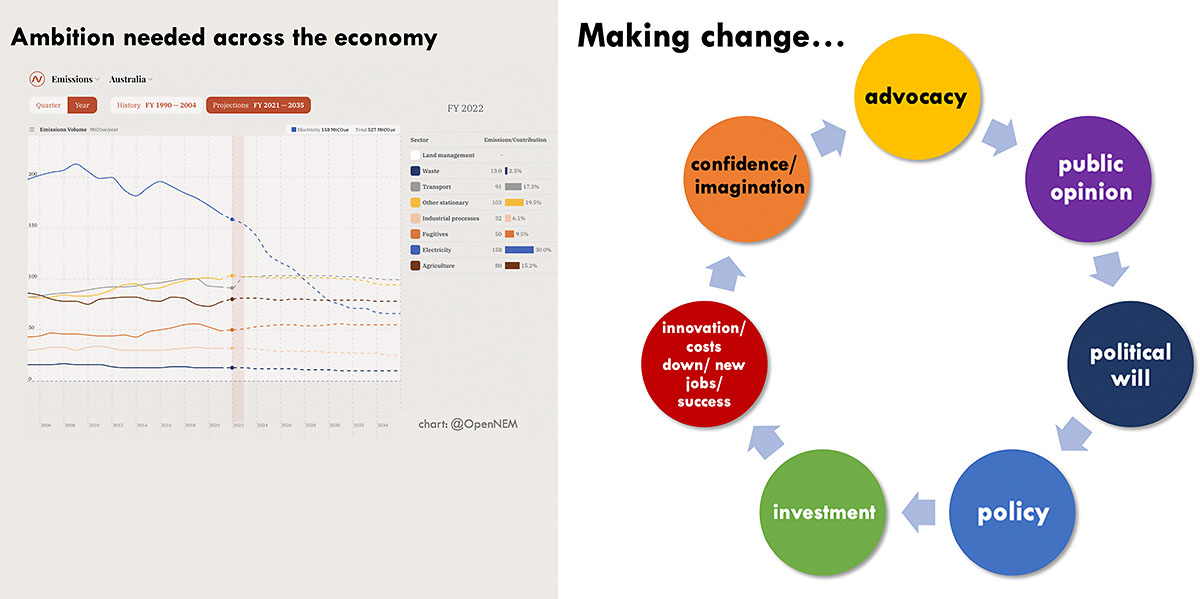
Advocacy drives structural change including better policies leading to positive changes in investment and innovation, particularly important for cross-sector decarbonisation
“I would like to talk briefly about my theory of change.” Personal action is well and good but “the real work is elsewhere, and that’s systemic change” creating a “virtuous cycle” with stronger public opinion from our advocacy shifting politics. Better policies drive investment and R&D, resulting in more innovation, and further progress in public opinion as we can see a more positive future.

The National Electricity Objective will soon have to account for emissions and decarbonisation.
The National Electricity Objective (NEO) will soon have to incorporate emissions.
“The national electricity objective. It basically says that at all times they’ve got to prioritise the affordability, reliability and safety of the electricity network and says nothing about emissions. And we’ve had this for the last 20 years in Australia. The Energy Ministers back in November-December agreed they want to change this and we’re about to see new legislation.”
Simon Holmes à Court

Mike Cannon-Brookes’ “crazy” plan is sparking not one, but two $20b tranches of green energy investment. Plus Victoria’s 2035 target is almost science-based
“So we’ve gone from two of the worst – AGL is the dirtiest company in Australia. Origin must be pretty close behind it. In one year both companies are on track for a $40 billion investment in decarbonisation.”
Simon Holmes à Court
Looking at Mike Cannon Brookes’ tilt at AGL: “Grok Ventures got control of AGL, didn’t have to buy as much of it as they thought they would to get control very quickly.” With new board members and a new attitude, AGL has allocated $20b for green power, also Brookfield with Origin Energy for another $20b of change. Victoria’s 2035 renewables target is now over 90%.
“18 months ago, the CEO of one of Queensland’s government owned coal generators at a conference said something as weak as “We might need to think about possibly using a bit less coal” and he was fired within 24 hours.
Eight months later Queensland announced they’re going to get out of coal, are going to close down all of their coal power generators by mid next decade.”
Simon Holmes à Court
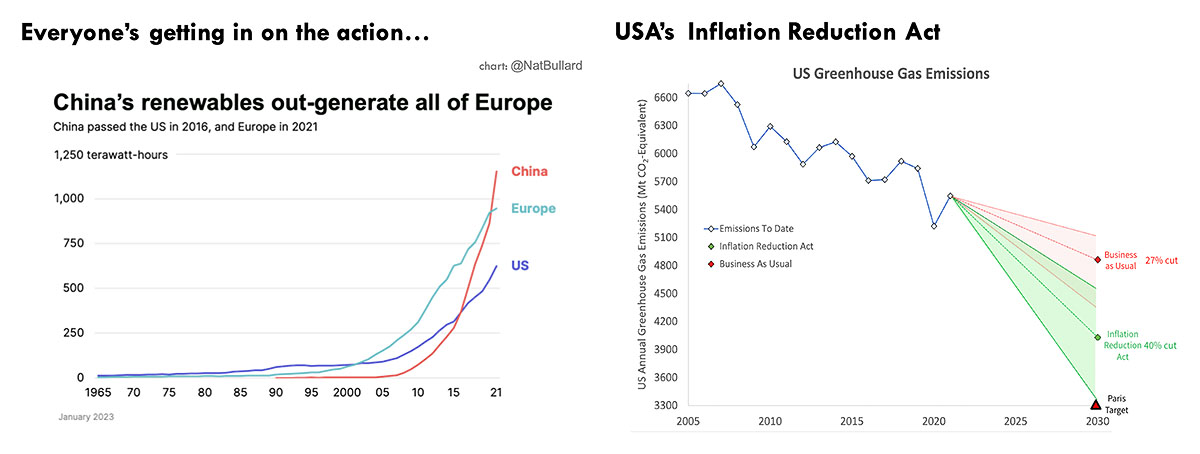
Both China and the US are spending big on clean energy, narrowing the window for Australia to take first mover advantage selectively in green energy and manufacturing opportunities
For context, we should consider China and the US. China spending big on renewables, US has made a huge shift with the Inflation Reduction (green investment) Act
Electric Vehicles
Electric Vehicle sales grew 50% in 2022, topping 10 million globally. The EV segment is the only growth segment in vehicle sales – “peak car” was 2017. As Bloomberg says, there are four car markets, and in one, buses, EV share is now 49%. Three times as many scooters are sold than cars, and 39% of them are now electric. For sales, the global car market is now 13%, and even in laggard Australia, EV sales nearly doubled last year, to now 3.7%.
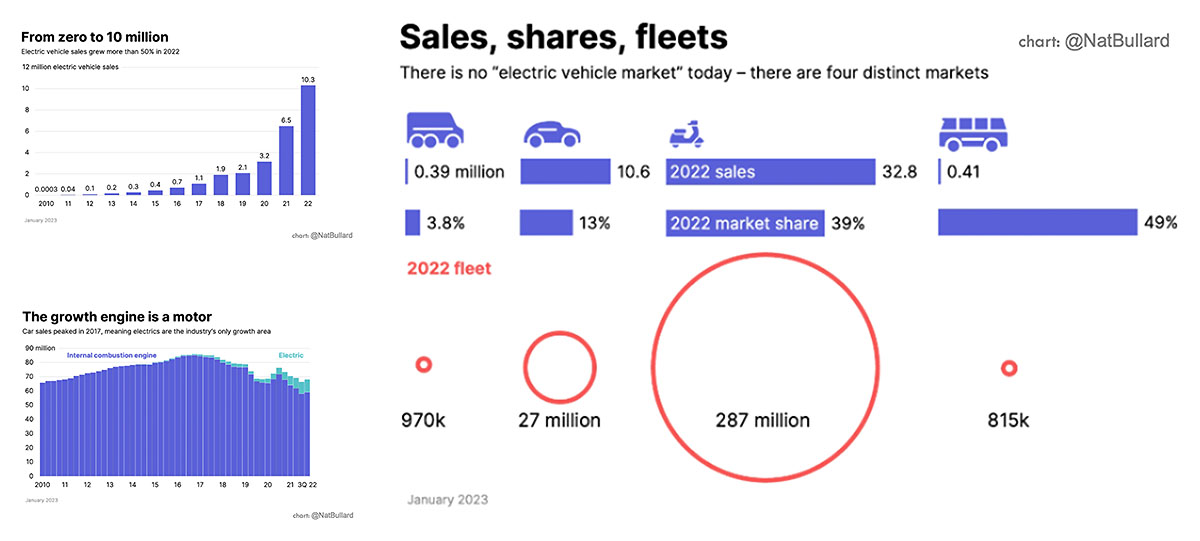
EVs are the only segment of the vehicle market that is growing. EV penetration is particularly strong in scooters and buses
Public charging increased by 50% in Australia, both in locations and number of chargers.
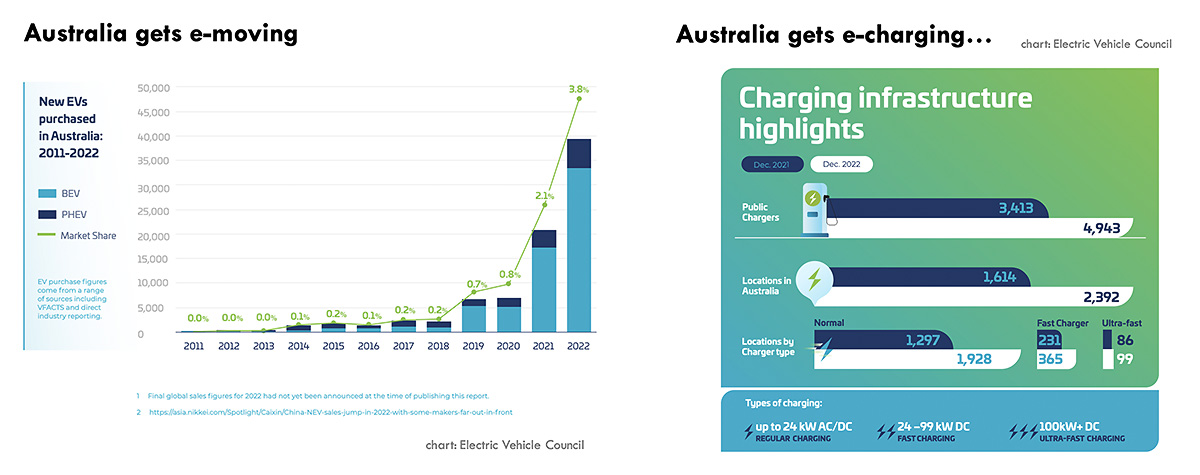
EVs in Australia have nearly doubled last year to 3.8%, and EV chargers have increased by around 50%
Very significantly in the US, the Model 3 Tesla is now $5000 cheaper to drive away from the lot than the average US car.
So what about those doubters who say that when it comes to carbon, EVs aren’t worth it? A very credible study looking at both manufacture and use in the EU found that even in the dirtiest grid, Poland, EVs are 40% cleaner, and in Germany EVs were 61% cleaner. Australia is somewhere between Poland and Germany, and our grid is getting cleaner all the time.
Big Wind
Wind turbines are just getting bigger. Simon noted that in December the largest blade ever made going off for testing, at 115 metres long, going into a 15 MW turbine, nearly three times as long as the blades at Hepburn wind farm. Not to be outdone, the Chinese outdid the Danes with a 140-metre blade, for an 18 MW turbine in January. These turbines are 10 to 20 times as powerful as the Hepburn turbines a decade earlier.

December 2022 – biggest ever blade at 115m for 15MW turbine, then outdone by 140m blade for 18MW turbine
And what about offshore wind in Australia? We can look to the success of Hywind, a 5-year-old Scottish offshore floating wind farm, working well up to 800m deep, the best-performing wind farm in the world due to the stronger winds in deeper waters. Five years ago off-shore wind was “don’t be silly”, to now serious investment from business and government with offshore wind zones including “The Hunter Valley Illawarra, Gippsland, Northern Tasmania, Portland, Bunbury and Perth.”
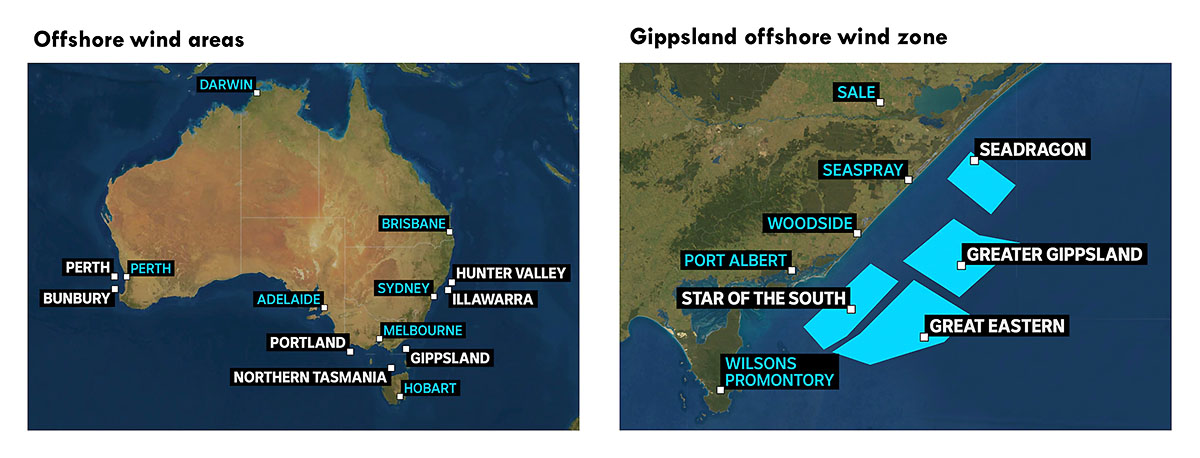
Advances in offshore wind technology and falling costs are driving uptake in Australia, starting in Gippsland with Star of the South due to start construction in three years.
“In the last few years, energy geeks have gone from saying we’ll probably never have offshore wind in Australia to there being a whole lot of companies looking at offshore wind and starting to peg out where it would be interesting.”
Simon Holmes à Court
Big Storage
Australia is taking up storage rapidly. Near Geelong, the Victorian Big Battery is the biggest “battery you’ve never heard of”. It’s three times the size of the famous Hornsdale Big Battery in South Australia.
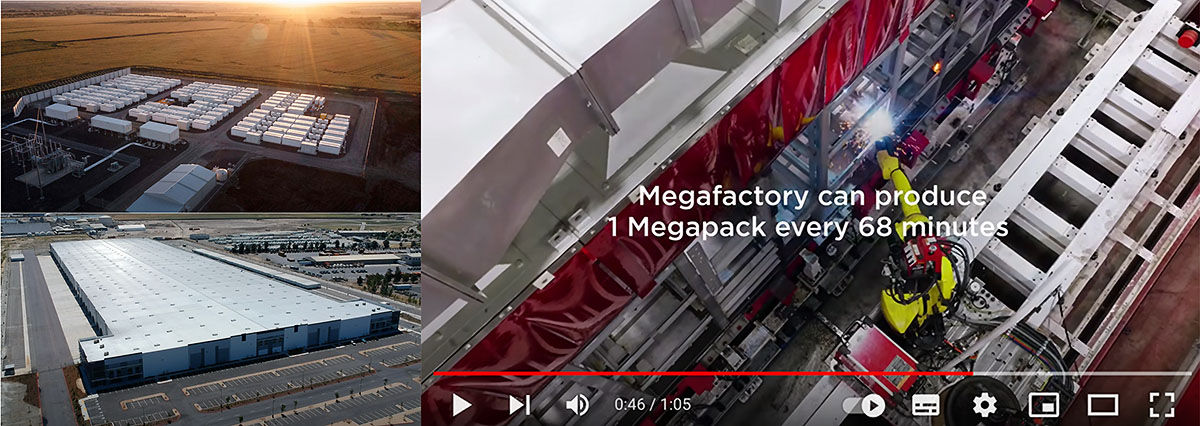
The Victorian Big Battery uses Tesla Megapacks made very efficiently in a Megafactory
Tesla built this megafactory in 15 months and it can pump out a megapack every 68 seconds.
“I did a quick calculation. A factory of this size could in a year produce as much batteries as Australia is going to need over the next decade.
So yeah, the question is why are we not setting up these kind of factories in Australia and supplying all of Australia but also our neighbours”?
Simon Holmes à Court
The big question is, with all our critical minerals and accelerated renewables taking up, why no megafactories in Australia, where we could also be supplying our neighbours to the north?
Big Opportunities
You could say that Australia has been blessed with an abundance of critical minerals as if God has tipped the periodic table all over Australia. This leads to opportunity on a mammoth scale – to take just one, the 27GW Asian Renewable Energy Hub would combine wind and solar with complementary load profiles to generate 3GW of low-cost green local power, creating affordable green hydrogen and ammonia for exports. It’s bigger than the Three Gorges Dam, and the first generation is expected in 2026-7.

On transition opportunities – we have all the resources and critical minerals we need – why not green manufacturing in Australia?
Australian innovators took a low-carbon cement process to Belgium, attracted by the EU carbon price and incentives. Sweden incentivised R&D into green steel and now the Hybrit plant is producing steel, like for this Volvo dump truck. Sweden is starting to decarbonise a difficult sector, using green hydrogen as a reductant. Why not in Australia?
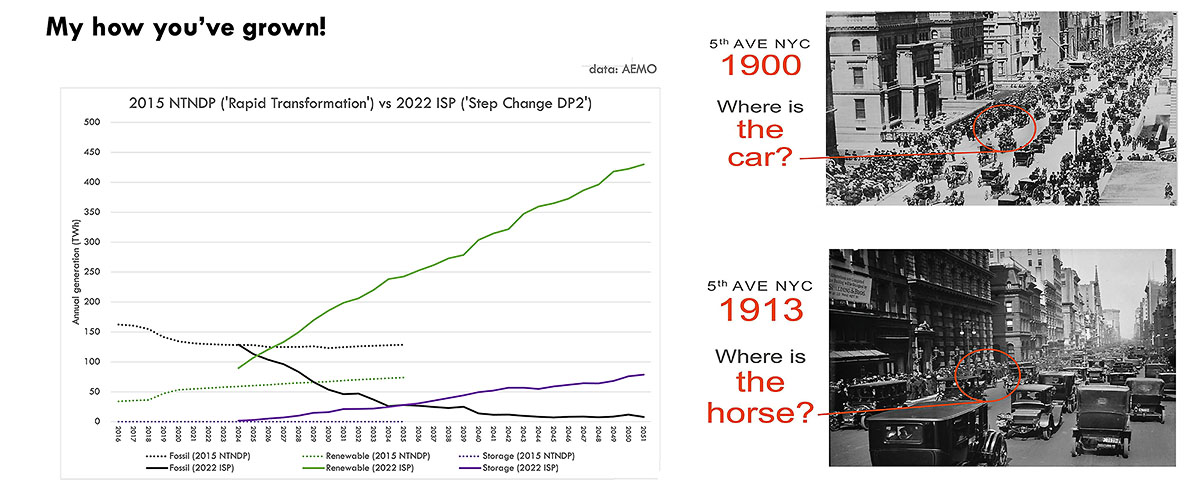
13 years – from horse to car. And in 7 years, AEMO’s projections for the growth of renewables have made a near-exponential shift
Yes, winning slowly is the same as losing, but in just 7 years our ambition has radically changed as you can see by comparing the slow rise of a 2015 projection for renewables to the inexorable rise of renewables in AEMO’s 2022 Step Change scenario. Change happens faster than we think, for instance in 1900 with one car in a crowd of horse-drawn vehicles to the reverse in 2013 on 5th Ave, New York City.

Lighter Footprints volunteers and allies at Innovate 2023
Simon placed the image of the virtuous circle behind him as a context for inspiring audience questions. Changes in public opinion and politics allow better climate and energy policy, leading to more investment and innovation.
Audience Questions
Question One on storage and transmission
Do we have enough? We have huge amounts of storage in residential garages, more than in big batteries. Simon had recently checked this out with guru Dylan McConnell who confirmed that we are building storage at a rate that would support AEMO’s faster predictions. “There is more more storage sitting in people’s garages than there are storage sitting in these massive battery farms. It’s probably a factor of 2 to 1″
Question Two – do we really need any new gas or coal to tide us through the transition?
AEMO’s modelling suggests about 10GW of gas through to 2040 and we have that. Simon doesn’t expect any new gas to be built, except some plants are very old and need to be refreshed. “We see the role of gas around about 6% of the national electricity market right now trending downwards. I don’t expect that to increase.”
Question Three on grid upgrades
The grid is getting more smart features, eg smart meter rollout, smart charging, for instance having Amber as your electricity provider where you are paying the market price for electricity (suiting those with PV and time controlled usage). The biggest challenge is the rise in air conditioner usage. Vehicle-to-grid will be important, as will aggregation or coordination services.
“I think coordination is fascinating in that with electric vehicles, if everyone comes home at night and plugs at the same time as they turn their air conditioner on and cook their dinner, it’s going to be the worst thing that ever happened to the grid. But if they or their electric vehicles subscribe to a service that tops them up when electricity is cheap and when electricity is greener – when when the wind’s blowing, the sun’s shining – then we can actually get a lot more out of our grid.”
Simon Holmes à Court
Question Four Advice on important political priorities
“Overriding we need higher emissions reduction targets. We need to see emissions reduction policies in other sectors, not just electricity.” Also funding for coordination (aggregation) and R&D funding for work on sector decarbonisation such as green steel and industrial processes.
“Australia, we have all the ingredients to come together to be making green steel. It’s crazy that we are shipping iron ore offshore and shipping our coal offshore for people to turn that iron ore into steel and sell it back to us as cars and dishwashers.”
Simon Holmes à Court
Question Five Discussion of PV end-of-life issues
Currently, the average solar panel in Australia is 3yrs old and will have lost only 10% capacity in 25yrs. PV is very recyclable (95%). Lithium battery recycling is solvable.
Question Six Discussion on Hydrogen
Hydrogen is mostly a storage mechanism, useful for increasingly less – now really only mid/long haul flight, green steel, high heat industrials. Hydrogen cars are difficult to charge. However there is a huge existing fertiliser market coming from gas, which could be considered for green hydrogen in the future.
“In theory there’s a lot of nice things about a hydrogen car. You can fill it up relatively quickly. At the moment there are only two hydrogen fueling stations in Australia – ones in Melbourne, one’s in Canberra and no hydrogen car has the range to go between the two. Of course that can be changed, and we once would have said the same thing about electric vehicles, but I think the killer is that the running cost is about three times as much as electric, And you can plug in your electric car in at home.”
Simon Holmes à Court
Question Seven EV charging and policies
The government is working on a charging black spot program. Critical needs include building code EV-ready policies for apartments and EV fleet policies to help seed a second hand market.
Question Eight Discussion about political donations and vested interests in terms of energy policy
We have technical and practical answers to get to 80% of decarbonisation, but progress is blocked politically – need to prime the virtuous cycle.
Question Nine What about fossil exports?
Australia’s coal and gas exports are 4x bigger than domestic usage. Our coal is not cleaner – we should be exporting green manufacturing and energy instead of relatively low value commodities.
Question Ten Barriers to industrial decarbonisation
Green steel is happening in Sweden now. Australian greener cement process was lured to Belgium with grants and EU carbon price. Hydrogen can produce 1600 deg for glass manufacture.

Lynn Frankes, Lighter Footprints Co-convenor thanks Simon Holmes à Court
Question Eleven How do you handle climate deniers?
If willing to deal honestly, try and find the first point of departure on facts. PV does pay back manufacturing energy in 12 months, and wind in 6 months.

So many questions! Thanks to Simon for engaging in detailed discussions post-event

